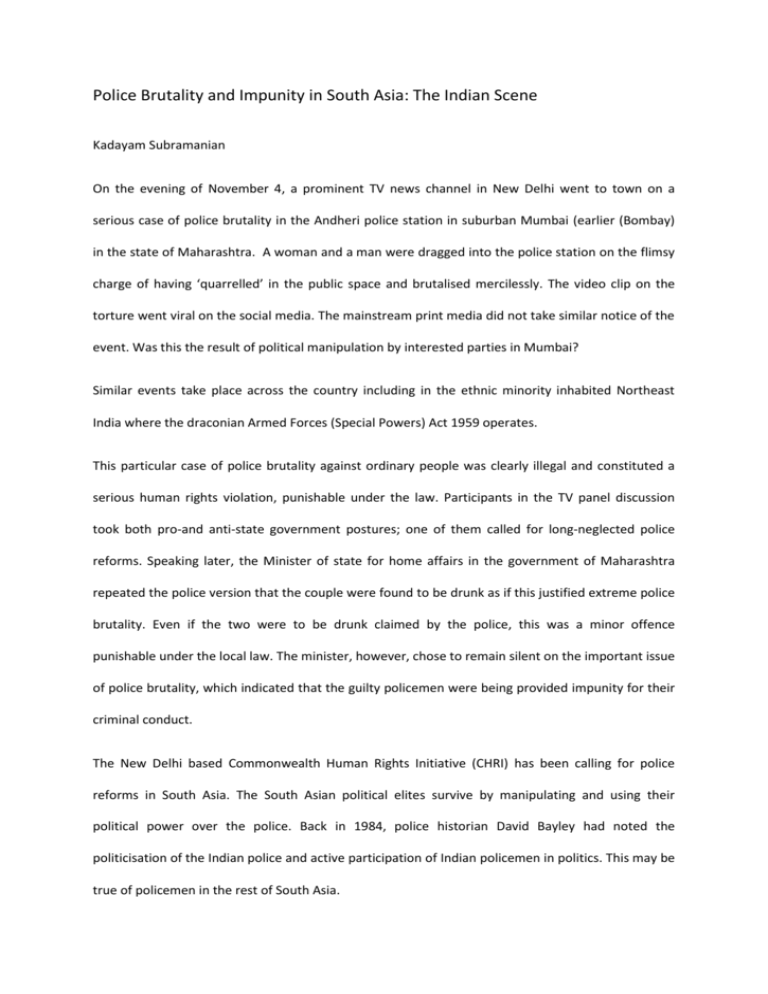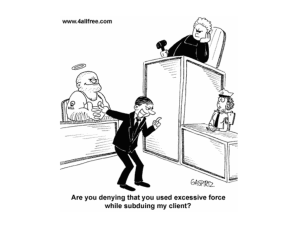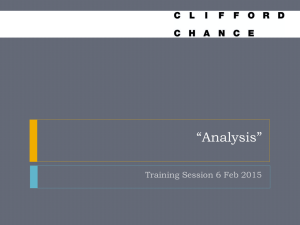
Police Brutality and Impunity in South Asia: The Indian Scene
Kadayam Subramanian
On the evening of November 4, a prominent TV news channel in New Delhi went to town on a
serious case of police brutality in the Andheri police station in suburban Mumbai (earlier (Bombay)
in the state of Maharashtra. A woman and a man were dragged into the police station on the flimsy
charge of having ‘quarrelled’ in the public space and brutalised mercilessly. The video clip on the
torture went viral on the social media. The mainstream print media did not take similar notice of the
event. Was this the result of political manipulation by interested parties in Mumbai?
Similar events take place across the country including in the ethnic minority inhabited Northeast
India where the draconian Armed Forces (Special Powers) Act 1959 operates.
This particular case of police brutality against ordinary people was clearly illegal and constituted a
serious human rights violation, punishable under the law. Participants in the TV panel discussion
took both pro-and anti-state government postures; one of them called for long-neglected police
reforms. Speaking later, the Minister of state for home affairs in the government of Maharashtra
repeated the police version that the couple were found to be drunk as if this justified extreme police
brutality. Even if the two were to be drunk claimed by the police, this was a minor offence
punishable under the local law. The minister, however, chose to remain silent on the important issue
of police brutality, which indicated that the guilty policemen were being provided impunity for their
criminal conduct.
The New Delhi based Commonwealth Human Rights Initiative (CHRI) has been calling for police
reforms in South Asia. The South Asian political elites survive by manipulating and using their
political power over the police. Back in 1984, police historian David Bayley had noted the
politicisation of the Indian police and active participation of Indian policemen in politics. This may be
true of policemen in the rest of South Asia.
Undivided India was divided into India and Pakistan in 1947. Sri Lanka emerged a little later.
Bangladesh arose out of Pakistan in 1971. The ‘Transfer of Power’ from the British to the South
Asian political elites involved the unchanged retention of the entire criminal justice system and the
repressive police and administrative structures of the Raj. A Constitution and a developmental
structure was superimposed on the pre-existing repressive colonial legal structure in India to meet
the rising aspirations of the people for development and justice, which were never met wholly or in
full measure. People’s struggles continued. So did police repression.
Why have the postcolonial South Asian states failed to carry out democratic reforms of the
administration and the police after attaining ‘independence’? After all, the South Asian liberals who
had fought for liberation from colonial rule had indeed promised development with justice. Why did
they fail to do what they had obviously intended to do? Did this have to do with the class character
of the new regimes?
Reforms of the criminal justice reforms in South Asia are essential to essential to wipe out the
currently dominant police brutality and ‘staged encounter killings’. Corruption and inefficiency are
the other aspects of the deterioration of the criminal justice system. The problem is complicated
because of the ‘symbiotic relationship’ between ruling politicians and policemen. The role of training
in explicating and implementing police accountability cannot be underestimated.
Accountability means an obligation or willingness to accept responsibility and account for one’s
actions. Accountability in the context of governance means that public officials have an obligation to
explain their decisions and actions to citizens. Accountability is achieved through various
mechanisms-political, legal and administrative. Setting up effective accountability mechanisms
requires a delicate balance between control and initiative. In the UK, there are 43 police forces with
a tripartite system of police accountability. In the US, there are 17,000 police forces each under the
control of their respective elected local government.
The complex task of balancing control over the use of police powers and the need for operational
autonomy has led in India to the proposal to divide police functions into prevention, investigation
and service provision. The police perform different functions and accountability is required for each.
It was proposed that the entire police service should be restructured so as to have two separate
agencies dealing with ‘investigation’ and ‘law and order’ with separate accountability mechanisms.
Further, the need was stressed for the setting up of independent District and State Police Complaints
Authorities (PCAs) to look into allegations of human rights violations and also an Independent
Inspectorate of Police as in the UK to establish a system of rigorous inspection of police stations and
the functioning of police officers. The inspectorate would also look into recurrent incidents of
dubious deaths in ‘encounters’ with the police. These proposals are yet to be implemented.
Key issues related to police’s image in South Asia remain to be addressed. In India, a gap between
the Constitutional imperatives and the inherited criminal laws and procedure, which give rise to the
enduring unpopularity of the police Inherited provisions of the Indian criminal laws are too
preoccupied with maintenance of security of the state, public order and collection of political
intelligence. Investigation and detection of criminal offences have been provided secondary
importance.
Police officers at all levels need to be sensitized to human rights. The National Human Rights
Commission in India has stated that 60 per cent of all the arrests made by the police are either illegal
or unnecessary; over 75 per cent of all the complaints of human rights violations received were
against the police.
Moreover, custodial violence, torture and extrajudicial executions continue with impunity. A 2008
report said that 1.8 million people were being tortured in police custody every year in India. The UN
Convention against Torture is yet to be ratified.
(The writer is a former Director General of Police in Northeast India and author of ‘State, policy and
Conflicts in Northeast India, Routledge, 2015)
Syed Nazakat, Editor-in-Chief,
Centre for Investigative Journalism, India
At the CIJ we stand for free, independent and watchdog journalism. Our aim is to share the skills,
values and expertise to serve the larger public good and advance the cause of free society. Our
endeavour is to create networks of innovation, collaboration and cooperation to grow and make a
difference. The change is not only possible, it's happening.
The ninth Global Investigative Journalism Conference at Lillehammer, Norway, is now less than a
year away.
THE Indian MUCKRAKER
Collection of watchdog reporting from India
•Blood for sale: India's illegal 'red market'
•How Forest Officers Net Their PhDs
•HT explains: What are ordinances?
•The debate over defence middlemen
•1984 anti-Sikh riots: Badal seeks PM Modi’s intervention
•Waste from 40,000km of drains choking Ganga
•Why segregated housing is thriving in India
•Bodos: Crisis of unresolved grievances
•Leaked data creates a scare that belies scientific projections
•What is India-U.S. Delhi Declaration of Friendship?
•What the Pentagon report really said about India & Pakistan
•India's White Paper on black money
STAY INFORMED
Subscribe
TRANSPARENCY
CIJ is dedicated to ensure all content we publish is accurate. If you find any inaccuracies let us know.
WRITE FOR US!
CIJ welcomes articles, letters and comments from readers. Please write to
editor@cij.co.in
SUPPORT OUR WORK
Your contribution to CIJ will help the cause of watchdog journalism in India.
Donate Now
Copyright © 2014. The Centre for Investigative Journalism, India. All Rights Reserved.
You are visitor no. baby shower gift
Designed & Developed By: ibex Solutions










